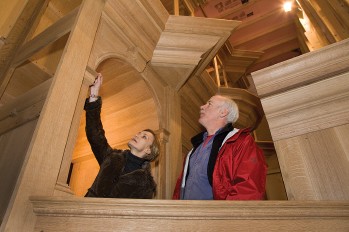ARTS AND HUMANITIES


Matt Parsons of Parsons Pipe Organ Co. burns the pipe racks for a precise fit when the pipes are installed. See larger image
Anabel Taylor Chapel organ will re-create sound of classic Baroque instruments
A new organ will fill Anabel Taylor Chapel with the authentic sound and beauty of German instruments from 300 years ago when it is completed this fall.
The result of a seven-year international organ studies research project undertaken by Cornell, the University of Gothenburg in Sweden and the Eastman School of Music in Rochester, N.Y., the entirely handcrafted organ will enhance the study and performance of organ music at Cornell.
For the past two years, 21st-century craftsmen have applied 17th- and early-18th-century methods to the fabrication and assembly of thousands of parts. The assembly in the chapel began in January and continued through the spring, with months of detail work and voicing the more than 1,800 pipes still ahead.
"Designing the organ is like composing the music," says Munetaka Yokota, lead researcher and designer on the $2 million project. "And voicing is kind of like a performance, making the sound come alive."
The instrument re-creates the tonal design of an organ at the castle chapel at Charlottenburg in Berlin, handmade in 1706 by master organ builder Arp Schnitger and destroyed by Allied bombers during WWII.
The pipes, made of tin, lead and white pine, were handcrafted in Sweden by Munetaka, a veteran of several major historic organ reconstructions. He will spend several months voicing the pipes before the first public concert with the organ in November.

University Organist Annette Richards and Lowe look over the woodwork of the Baroque-style organ. See larger image
"Every pipe has its own voice, its own character, its own way of speaking," says university organist and music professor Annette Richards.
Commissioned by Cornell's Department of Music, the organ will be used for solo repertoire, such as the music of J.S. Bach, and vocal and instrumental ensemble accompaniment. It will also complement department strengths in performance and research in music of the 17th to 19th centuries and attract top organists and composers.
More than a curatorial reconstruction, the project is "a wonderful way to inspire new skills, ideas and musical activities," Richards says. "The organ was absolutely central to Western culture into the early 20th century. Learning from the past, we're transplanting and nurturing a whole new set of ways of making, maintaining and, of course, playing these gorgeous works of art."
"For the player, you can really make music with this," Richards said of the organ's keyboard action during a demonstration in April.
The organ has 1,827 pipes in 42 rows; two 50-note keyboards and a 26-note pedal; 30 stops, with instrument voices such as transverse flute, oboe and viola da gamba; and four large wood-and-cowhide bellows in a room above the chapel. The bellows (each weighing more than 400 pounds) are designed to be operated manually; the only non-historic component is an electric motor to pump air into the bellows to assist solo players, Munetaka says.

Cabinetmaker Christopher Lowe, center, and workers from Parsons Pipe Organ Co. install part of the wooden case for the Anabel Taylor Chapel Baroque-style organ. See larger image
The organ research involved fluid dynamics, electro-acoustics and metallurgy, among other disciplines, he says: "Many scientists worked with us in helping us to understand this early wind-bellows technology."
The bellows, wind chests and many complex parts of the key and stop action were handcrafted under Munetaka's supervision at the Parsons Pipe Organ Co. in Bristol, N.Y.
The massive, intricately designed organ case of quarter-sawn white oak is integrated into the chapel's existing woodwork. Case components were handcrafted by cabinetmaker Christopher Lowe in nearby Freeville, N.Y.
"This is the first experience for Chris on a project this size; he has been dreaming of this," Munetaka says. "He makes things in the older style, and he was very enthusiastic."
The case work involved no sanding; instead, Lowe and helpers planed the wood to within 1/32 of an inch. The case is held together by hand-forged nails and hardware fabricated by an ironworker in Sweden, wooden pegs, and dovetail and mortise and tenon joints.
The oak came from Pennsylvania and the 18-foot-tall pedal-tower sides from a sustainable forest in Germany.
"Every tree has its own place to be used," Munetaka says. "I think it's a beautiful thing to use everything in the most intelligent way. Materials used in the old way, the closest to the original conditions in nature, are best."
Cornell's Office of General Construction and union trade shops were an integral part of the organ installation, Richards says.
The first concert is planned for Nov. 21, and an inaugural celebration will be held March 10-13, 2011.

The Anabel Taylor Chapel organ features a massive wooden case of quarter-sawn white oak. The components were handcrafted in the Freeville, N.Y., shop of Christopher Lowe (on ladder). Inset: Lead designer/researcher Munetaka Yokota, who will voice the organ's more than 1,800 pipes.